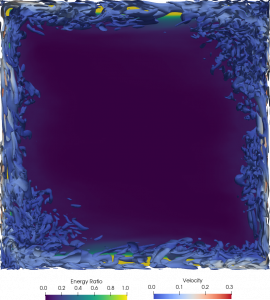Concerning hybrid RANS/LES approaches, my research focuses on two aspects: the generation of synthetic turbulence to enrich the solution in the transition zone from RANS to LES; the development of the continuous hybrid RANS/LES methodology, seeking to link the models, and in particular the hybridization method (the way to trigger the switch from RANS to LES and vice versa), to a formalism that is as rigorous as possible, avoiding at most the usual empiricism of these approaches.
For synthetic turbulence generation, in collaboration with EDF, we have developed an original approach (DeLaageDeMeux et al., 2015), based on volume forcing in a transition zone, which appears to be a very interesting method compared to its competitors.
A substantial activity has focused on continuous hybrid RANS/LES modeling with transport equations for subfilter stresses (Fadai-Ghotbi et al., 2010 ; Friess et al.). A temporal filtering formalism was developed in order to make the approach compatible with practical applications in inhomogeneous flows (Fadai-Ghotbi et al., 2010b) leading to the HTLES method (Manceau, 2016).
Development of the HTLES approach (Hybrid Temporal LES)
HTLES (cf. Manceau 2019) performed with Code_Saturne of a jet in crossflow(F. Mastrippolito, R. Manceau, P. Bruel).
Enrichment of the LES zone by anisotropic linear forcing (ALF)

Flow in a series of hills. Solution given by the HTLES wih a steady inflow condition without (top) and with (bottom) volume forcing. From Duffal (2020).
HTLES for the computation of unsteady loads
Periodic hill flow. Comparison of the pressure spectra obtained in the vicinity of the reattachment point with LES and HTLES with two different grids. From Duffal (2020).
Application to engines
Flow in the Darmstadt engine. From Al Afailal (2020).
Extension to natural convection
HTLES simulation in a differentially heated square cavity. From Bikkanahally et al. (2021).






